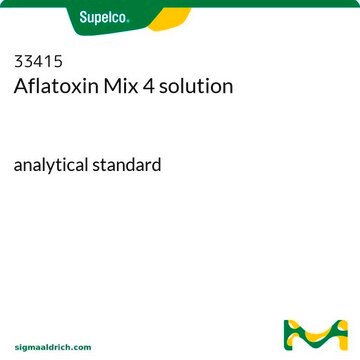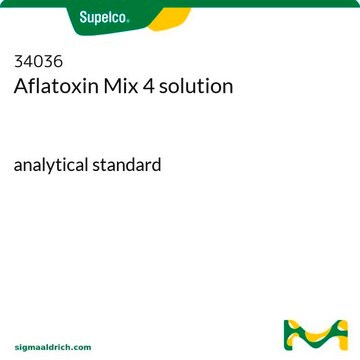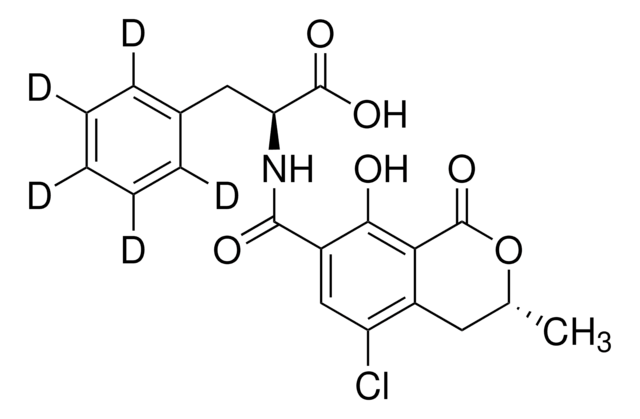32764
Aflatoxin B1-13C17 solution
~0.5 μg/mL in acetonitrile, analytical standard
Synonim(y):
Fully 13C-labelled Aflatoxin B1
About This Item
Polecane produkty
klasa czystości
analytical standard
okres trwałości
limited shelf life, expiry date on the label
stężenie
~0.5 μg/mL in acetonitrile
metody
HPLC: suitable
gas chromatography (GC): suitable
Zastosowanie
cleaning products
cosmetics
food and beverages
personal care
format
single component solution
przesunięcie masy
M+17
temp. przechowywania
−20°C
ciąg SMILES
[13CH3]O[13c]1[13cH][13c]2O[13C@H]3O[13CH]=[13CH][13C@H]3[13c]2[13c]4O[13C](=O)[13C]5=[13C]([13CH2][13CH2][13C]5=O)[13c]14
InChI
1S/C17H12O6/c1-20-10-6-11-14(8-4-5-21-17(8)22-11)15-13(10)7-2-3-9(18)12(7)16(19)23-15/h4-6,8,17H,2-3H2,1H3/t8-,17+/m0/s1/i1+1,2+1,3+1,4+1,5+1,6+1,7+1,8+1,9+1,10+1,11+1,12+1,13+1,14+1,15+1,16+1,17+1
Klucz InChI
OQIQSTLJSLGHID-DENWKYDXSA-N
Powiązane kategorie
Opis ogólny
Zastosowanie
Komentarz do analizy
Inne uwagi
Hasło ostrzegawcze
Danger
Zwroty wskazujące rodzaj zagrożenia
Zwroty wskazujące środki ostrożności
Klasyfikacja zagrożeń
Acute Tox. 4 Dermal - Acute Tox. 4 Inhalation - Acute Tox. 4 Oral - Eye Irrit. 2 - Flam. Liq. 2
Kod klasy składowania
3 - Flammable liquids
Klasa zagrożenia wodnego (WGK)
WGK 2
Temperatura zapłonu (°F)
35.6 °F - closed cup
Temperatura zapłonu (°C)
2.0 °C - closed cup
Środki ochrony indywidualnej
Eyeshields, Faceshields, Gloves, type ABEK (EN14387) respirator filter
Choose from one of the most recent versions:
Masz już ten produkt?
Dokumenty związane z niedawno zakupionymi produktami zostały zamieszczone w Bibliotece dokumentów.
Klienci oglądali również te produkty
Nasz zespół naukowców ma doświadczenie we wszystkich obszarach badań, w tym w naukach przyrodniczych, materiałoznawstwie, syntezie chemicznej, chromatografii, analityce i wielu innych dziedzinach.
Skontaktuj się z zespołem ds. pomocy technicznej












